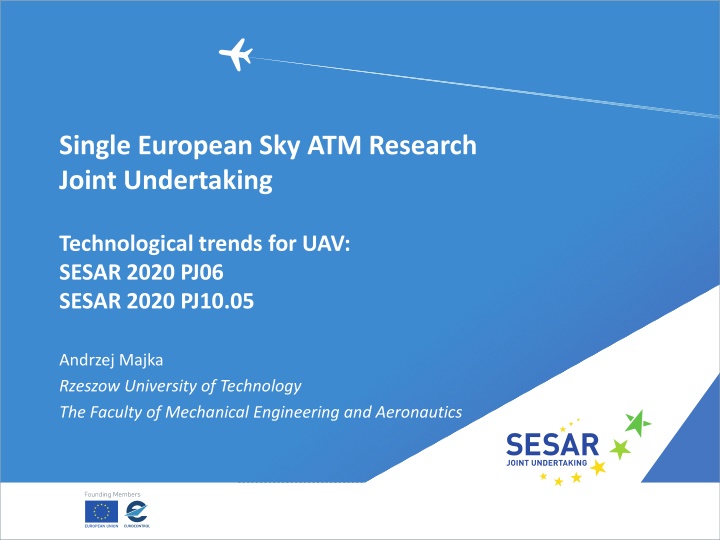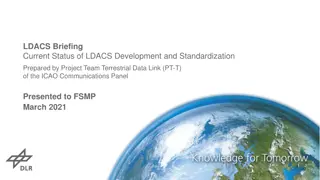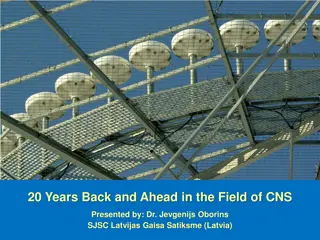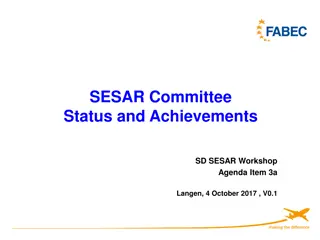
Innovative UAV Technology Trends in European ATM Research Undertaking
Explore the latest advancements in UAV technology through the SESAR 2020 project, focusing on performance-based free routing in lower airspace. Rzeszow University of Technology introduces new flight planning methods for optimal aircraft paths, enhancing predictability and efficiency for various airspace users.
Download Presentation

Please find below an Image/Link to download the presentation.
The content on the website is provided AS IS for your information and personal use only. It may not be sold, licensed, or shared on other websites without obtaining consent from the author. If you encounter any issues during the download, it is possible that the publisher has removed the file from their server.
You are allowed to download the files provided on this website for personal or commercial use, subject to the condition that they are used lawfully. All files are the property of their respective owners.
The content on the website is provided AS IS for your information and personal use only. It may not be sold, licensed, or shared on other websites without obtaining consent from the author.
E N D
Presentation Transcript
Single European Sky ATM Research Joint Undertaking Technological trends for UAV: SESAR 2020 PJ06 SESAR 2020 PJ10.05 Andrzej Majka Rzeszow University of Technology The Faculty of Mechanical Engineering and Aeronautics 1
Vision The objective of SESAR is to modernise European ATM by defining, developing and delivering new or improved technologies and procedures (SESAR Solutions). 2
Vision 3
SESAR 2020 PJ06-02 ToBeFREE Management of Performance Based Free Routing in Lower Airspace 4
SESAR 2020 PJ06 ToBeFREE Management of Performance Based Free Routing in Lower Airspace Management of Performance Based Free Routing in lower airspace sees the application of FRA for airspace users below FL305, improving predictability, flexibility for a wider range of different airspace users. efficiency and 5
SESAR 2020 PJ06 ToBeFREE Management of Performance Based Free Routing in Lower Airspace Integration of RPAS into the airspace between 500ft and 60,000ft as either IFR or VFR is challenging due to the fact that RPAS will have to fit into the ATM environment with the same level of safety as manned aviation. 6
SESAR 2020 PJ06 ToBeFREE Management of Performance Based Free Routing in Lower Airspace Free Route operations shall allow Airspace Users, including General Aviation, Rotorcraft and RPAS, to significantly optimize flight trajectories over a large-scale area of interest (e.g. multiple FIR or FABs), within high & very high-complexity environments, according to user defined segments 7
SESAR 2020 PJ06 ToBeFREE Management of Performance Based Free Routing in Lower Airspace Rzeszow University of Technology proposed a new flight planning method and airspace model, which can be used for determination of optimal path of aircraft (manned and unmanned), at the stage of preparing a flight plan according to FRA rules. 8
SESAR 2020 PJ10 PROSA IFR RPAS Integration 9
SESAR 2020 PJ10 PROSA IFR RPAS Integration This work provides the technical capability or procedural means to allow drones to comply with air traffic control instructions 10
SESAR 2020 PJ10 PROSA IFR RPAS Integration According to Roadmap for the integration of civil RPAS into the European Aviation System (European RPAS Steering Group, June 2013), one of the main goal is to develop harmonised and common rules for operation of the RPAS to open the internal EU market, with priority to RPA of 150 Kg or less. 11
SESAR 2020 PJ10 PROSA IFR RPAS Integration Currently, there is a lack of standardized procedures, technical, and technological requirements regarding RPAS, which are the main obstacles in integration of RPAS in the frames of non- segregated airspace. Technological gaps have been identified in six areas: detect and avoid systems and operational procedures; data communication links, including spectrum issues; surface operations, including take-off and landing and integration into ATM and airspace environments; contingency; human factors; security issues. 12
SESAR 2020 PJ10 PROSA IFR RPAS Integration The majority of RPAS are characterized by worse performance properties in comparison to commercial airliners, despite performing their tasks at similar heights. Generally, lower weight RPAS s are unable of reaching the vertical acceleration/speeds required for sufficient vertical or horizontal manoeuvres or manoeuvres with wind. 13
SESAR 2020 PJ10 PROSA IFR RPAS Integration According to the scope of the Solution 10-05, for a safe RPAS IFR integration into non-segregated airspace, the RPAS should be compliant with ATM rules and ATC related systems, navigation precision and should be integrated with other manned traffic. Therefore Validation Exercises performed by Rzeszow University Technology were aimed to RPAS realized certified EASA category operations, based on the RPAS class VI Traffic concept of operations of EUROCONTROL. 14
SESAR 2020 PJ10 PROSA IFR RPAS Integration The conclusions will identify the main parameters of RPA performance, in order to accomplish this type of TMA procedures. If it turns out that these performance requirements are excessive, the conclusion will be made that it is necessary to create a new performance subcategory for light RPA (with weight close or slightly higher than 150 kg). 15
Contact: Department of Aircraft and Aircraft Engines Faculty of Mechanical Engineering and Aeronautics Rzeszow University of Technology Address: ul. Powstancow Warszawy 8 35-959 Rzeszow, POLAND phone: +48 17 865 1604 mobile: +48 602 441 977 web: www.prz.edu.pl/ksisl e-mail: andrzej.majka@prz.edu.pl 17






